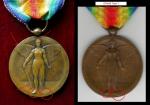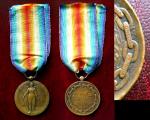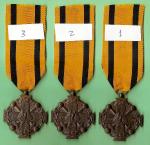
Tim B
Past Contributor-
Posts
2,234 -
Joined
-
Last visited
-
Days Won
2
Content Type
Profiles
Forums
Blogs
Gallery
Events
Store
Everything posted by Tim B
-
Never seen one like it, thanks for showing it Dieter! Tim
-
Romanian Victory Medals
Tim B replied to Kev in Deva's topic in Inter-Allied Victory Medals of the Great War
Hi Rob, That is what I thought might be the case on the one I posted questions on above. I still think there are slight differences on that one from the original that you show. The problem with the Rumanian VIC's, are so many unofficial ones are out there in original groups due to the problems/limitations with the official mint back then. Tim This one was listed recently; nice group!! -
Damn, where's TSA when you really need them; uh, sorry sir, but that looks dangerous and we are going to have to confiscate and dispose of that item for you! hehehe Congrats again Frank, and it sounds like you have a great wife btw! Tim
-
Romanian Victory Medals
Tim B replied to Kev in Deva's topic in Inter-Allied Victory Medals of the Great War
Hi guys! Thanks for the close-ups Rob, that will help as there is only one die to really compare originals to. JM, that is a good reference to have!! The problem of poor seller's PIC's will still be the remaining issue here but, I now have a little more to use for comparisons. Again, many thanks!! Tim -
Greece - Help please ID Ribbon bar
Tim B replied to Noor's topic in Southern European & Balkan States
Hi Timo, I would say you're missing the star on that one. Here's a reference link for you: http://www.medals.org.uk/greece/greece-ribbons.htm Tim -
Italy - Strugling with Italian ribbon bars
Tim B replied to Noor's topic in Southern European & Balkan States
Timo, It's missing the earlier ones, but it might have some listed. There's a page 2 as well to check out. http://www.medals.org.uk/italy/republic/italian-republic-ribbons.htm Tim -
Romanian Victory Medals
Tim B replied to Kev in Deva's topic in Inter-Allied Victory Medals of the Great War
Thanks Rob! Yes, sometimes the scans are just too fuzzy to make out the finer details. I had thought it might be an original Type 1 and almost went for it, but in the end, I opted to find a better conditioned one that leaves no doubts. So, to the best of your knowledge, are there copies out there with the "Kristesko" stamp? Much appreciated, Tim -
Romanian Victory Medals
Tim B replied to Kev in Deva's topic in Inter-Allied Victory Medals of the Great War
-
Romanian Victory Medals
Tim B replied to Kev in Deva's topic in Inter-Allied Victory Medals of the Great War
Here's a comparison of the front compared to Rob's Official Type 1 shown earlier in the thread. Note just some of the areas called out. - The hair seems slightly more cropped on this one as compared to the original (right). - The left wing appears ever so slightly shorter. Not sure if it's just the lighting or angle, but it looks differernt. - The sword has a noticeable taper, more so than the original Type 1 shows. - Victory's right foot (on the left) dips further down over the exergue than it does on the original Type 1. - The drape of the dress does not come to a point as it does on the original. Tim -
Romanian Victory Medals
Tim B replied to Kev in Deva's topic in Inter-Allied Victory Medals of the Great War
Let's backtrack for a moment to the Rumanian VIC. Understanding the Laslo reference is now somewhat dated, with more information coming to light since his last revision in 1992 and more items being seen these days on the market; what do you think of this piece? It was listed as an original with the designer's name "Kristesko" on the reverse. However, there are noticeable die differences between the official Type 1 that Laslo describes in his book and this one. Is this another modern example with the name added, or is it an authentic version Laslo did not cover? Tim -
Greece - Devices to Greek ribbon bars
Tim B replied to Lukasz Gaszewski's topic in Southern European & Balkan States
Hello Kevin! Thanks for posting that image showing the ribbon attachments. That clearly shows a noticable difference in the size of the stars. Also interesting, is the style of the "laurel branch", which looks strikingly similar to the French style "palm" used during the same time period. What do you make of the one I show in the last post? Tim -
American (US) Victory Medals
Tim B replied to Kev in Deva's topic in Inter-Allied Victory Medals of the Great War
Concerning the manufacture/origin of those battle clasps thought to be French produced. Do we know how many French manufacturers actually produced clasps for these medals? Since collecting French ODM's, I have found that there were several manufacturers producing a wide variety of items during this period, and can only assume more than just a few might have also produced these clasps, official or otherwise. I have to lean towards what JM is alluding to and ask, if not the French, then who? IMO, the market would have been French and the US, not other countries that didn't utilize these clasps for their medals, nor had large after market demands for "foreign" pieces. Based on how many countries had France producing their ODM's at one point or other in time, and the prolific number of manufacturers that produced official and unofficial awards, I would put my money on the French being the source here. Just my opinions. Tim -
Greece - Military Medal of Merits
Tim B replied to Tim B's topic in Southern European & Balkan States
I haven't seen the version you mentioned with six feathers. Do you have a PIC to show here? I was told, the version with ELLAS and no dates on the reverse is the rarest of all versions. I have not seen one of those either. Cheers! Tim -
Greece - Military Medal of Merits
Tim B replied to Tim B's topic in Southern European & Balkan States
-
Greece - Military Medal of Merits
Tim B replied to Tim B's topic in Southern European & Balkan States
Just to make sure those minor die characteristics weren't specific to one piece, here's three identical Merit Medals. -
Greece - Military Medal of Merits
Tim B replied to Tim B's topic in Southern European & Balkan States
Here's a side by side comparison of the two ANAGNOSTOPOULOS pieces. The one on the left is the earlier and the one on the right is what I believe the later with die differences. Note the red circled areas: The two smaller circles show a deeper indentation on the leaves and would indicate either a worn or dirty die, or retooling after the die may have worn down and needed to be cleaned up. The indentations could not have come earlier and then "disappeared" on the other version, so this had to happen later on in production. The larger circled area points to a particular leaf and if you look carefully at the leaf tip, you can see the original "swirl" is still there but, the leaf design has changed and now shows a shorter tip as well. Again, this points to a later change IMO. Tim -
Greece - Military Medal of Merits
Tim B replied to Tim B's topic in Southern European & Balkan States
Here's another example by ANAGNOSTOPOULOS. This is, IMO, a later produced piece. Either a reworked die, or a 2nd die that might have had some changes made from the original. Very similar in appearance with minor leaf differences. Note, the "7" is identical. Tim -
Greece - Military Medal of Merits
Tim B replied to Tim B's topic in Southern European & Balkan States
As before; looking at the leaves on the front, these appear to be very sculpted with the veins much more pronounced compared to the other versions by other manufacturers. I've put some arrows up to point out a couple of the areas to show what I mean here. On the reverse, note the shape/style of the number "7". This is common on all ANAGNOSTOPOULOS Merit Medals that I have seen and is different from the other makers. Tim -
Greece - Military Medal of Merits
Tim B replied to Tim B's topic in Southern European & Balkan States
The next one I will show is that of ANAGNOSTOPOULOS. These appear to be the most common ones encountered, at least currently. Looking at some PIC's, I believe that this one might have had multiple dies, or possibly a reworked die at some point in time and I'll show why I think that as the posts follow. Tim -
Greece - Military Medal of Merits
Tim B replied to Tim B's topic in Southern European & Balkan States
This one could also be Kelaidis, though I am not sure. The general die characteristics look the same but, if you look closely at the date numerals, they appear slightly different. Tim -
Greece - Military Medal of Merits
Tim B replied to Tim B's topic in Southern European & Balkan States
Here's a Kelaidis example: Again, one of the main differing areas on these are the style of leaves on the front and in some, the style of numbers used on the reverse dates. I am not sure if there were any variations in this manufacturer. Tim -
Greece - Military Medal of Merits
Tim B replied to Tim B's topic in Southern European & Balkan States
Hi Kev! Finally have some time to sit down and put up what I have thus far. I have to utilize PIC's taken from other sources for these examples as I am waiting on mine at the moment. Here is an example of the Rivaud type medal. Note the narrow leaves on the front, and of course the stamping of: L.Süe (Sculptor) A.A.Rivaud (Designer) Salonique 1917 on the reverse (black arrow). This example has the ball-type suspension and I understand there is also a rarer version that utilizes a small attachment ring instead of the "ball". Tim ** Added a better PIC ** -
Greece - Military Medal of Merits
Tim B replied to Tim B's topic in Southern European & Balkan States
Hi Kevin! I think you're correct here and there seems to be some variation even among manufacturers. I have to run around today but, I have been working with a collector in Greece and think I have identified the different styles to Rivaud, Kelaidis, and Anagnostopoulos for starters. Once I am sure of these, I will post examples with some die characteristics called out. Cheers my friend! Tim -
Greece - Military Medal of Merits
Tim B replied to Tim B's topic in Southern European & Balkan States
One more comparison here; note that the die characteristics are slightly different on the leaves. The example on the right is clearly more refined in the strike than the other. Also, note the suspension ball is rounder on the more "refined" example as well. Clearly "ball" shaped and not squeezed like the other one. You can see this difference between the examples in post 14 & 15 as well. Different manufacture; time period? ... Thoughts? Tim -
I had asked some questions on these medals in another thread dedicated to the ribbon attachments that went on various Greek awards and thought it would be better to start a separate thread instead of taking that thread too far off topic. So, I'll move my last two posts here to start. On the 1917 version of the Military Merit Medal, I wanted to ask if there was a difference in the coloration of the medal itself? I notice on Megan's site: http://www.medals.org.uk/greece/greece017.htm the different levels of the award are slightly different in tone and wanted to know if these were all bronze with slightly different finishes, or if the medals also had different colors depending on award level? I'll post a comparison to show what I am referring to below. One clearly looks more dark bronze while the other has a golden look to it. Is it possible that the darker ones are more modern strikes, or is it just the finish fading over time, perhaps due to metals used? I understand that the same medal was initially used in 1940 (Medal for Outstanding Acts) until a change in design came about. After that, I think the original medal was no longer manufactured? Tim
















